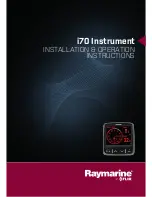
Millikan Oil Drop Apparatus
Historical Information
®
16
012-13093B
5
Millikan, Robert A., p. 115,
6
Millikan, Robert A., p. 110,
7
Millikan, Robert A., p. 116.
With this new apparatus hundreds of measurements on different drops were made, for the purpose of both making
an exact evaluation of
e
and proving or disproving the atomic theory of electricity. The value of
e
that was
obtained from these five years of work was 4.774 x 10
-10
e.s.u. This value of
e
was accepted until 1928 when a
precise determination of Avogadro’s number by X-ray diffraction measurements on crystals permitted the calcula-
tion of
e
to be 4.803 x 10
-10
e.s.u. The discrepancy was later traced to Millikan’s too low value for the viscosity of
air.
Atomic Nature of Electricity
The atomic nature of electricity is best exemplified by the following table taken from Millikan’s data:
Millikan makes the following comments about this table.
“In this table 4.917 is merely a number obtained . . . from the change in speed due to the capture of ions and one
which is proportional in this experiment to the ionic charge. The column headed 4.917 x n contains simply the
whole series of exact multiples of this number from 1 to 18. The column headed ‘Observed Charge’ gives the suc-
cessive observed values of the rising velocity of the drop plus the falling velocity. It will be seen that during the
time of observation, about four hours, this drop carried all possible multiples of the elementary charge from 4 to
17, save only 15. No more exact or more consistent multiple relationship is found in the data which chemists have
amassed on the combining powers of the elements and on which the atomic theory of matter rests than is found in
the foregoing numbers.
Such tables as these—and scores of them could be given—place beyond all question the view that an electrical
charge wherever it is found, whether on an insulator or conductor, whether in electrolytes or in metals, has a defi-
nite granular structure, that it consists of an exact number of specks of electricity (electrons) all exactly alike,
which in static phenomena are scattered over the surface of the charged body and in current phenomena are drift-
ing along the conductor. Instead of giving up, as Maxwell thought we should some day do, the ‘provisional
hypothesis of molecular charges,’ we find ourselves obliged to make all our interpretations of electrical phenom-
ena, metallic as well as electrolytic, in terms of it.”
8
8
Millikan, Robert A., pp. 74–75
Although the values of the charge on a specific drop were found to be exact multiples of a certain value (
e
), the
value of
e
varied for drops of different masses. This discrepancy was traced to the breakdown of Stokes’ Law.
Through experimentation the law was found to fail when the size of the drop approached the mean free path of air
molecules. When this situation occurs, the medium in which the drop falls is no longer homogeneous in relation to
the drop. This contradicts one of the assumptions upon which Stokes’ Law is based. Through his work on the elec-
tron, Millikan was able to determine a correction factor for Stokes’ Law.
By performing the experiment with mercury drops and drops of other materials, Millikan demonstrated that the
elementary electrical charge was the same for insulators, semi-conductors, and conductors. He also demonstrated
that the beta particle had the same charge as an electron (indeed, it is an electron) and that positive and negative
electrons (the positive electron referring to a proton and not a positron) are equal in charge. The experiment also
produced insights into the study of ionized gasses.
Table 1.2:
n
4.917 x n
Observed Charge
n
4.917 x n
Observed Charge
n
4.917 x n
Observed charge
1
4.917
-----
7
34.42
34.47
13
63.92
63.68
2
9.834
-----
8
39.34
39.38
14
68.84
68.65
3
14.75
-----
9
44.25
44.42
15
73.75
-----
4
19.66
19.66
10
49.17
49.41
16
78.67
78.34
5
24.59
24.60
11
54.09
53.91
17
83.59
83.22
6
29.50
29.62
12
59.00
59.12
18
88.51
-----





































